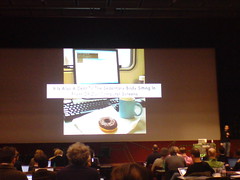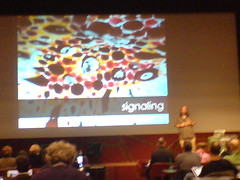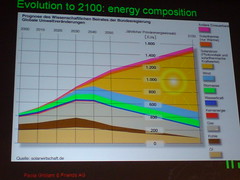Limo
February 08, 2007 | CommentsThe Limo foundation has launched. If I could read their site (currently broken) I might be able to tell more, Andrea has commented on it here.
Handsets are becoming more advanced and gaining functions previously associated with the smartphone category. They therefore need a more modern OS. Nokia shipped 106m handsets last quarter; if they're paying $7.5 per handset for a Symbian license, handset sales stay steady, and more and more handsets need a Symbian-level OS, then in a few years time they'll have an annual bill for $3.18bn.
Oh alright - it won't be this bad, maybe not every handset will be SymbianOS and maybe they'll have negotiated discounts from Symbian - but it's still a lot of money. And if in the meantime processors are getting faster and others are demonstrating that you can build a handset atop an OS with UNIX roots... Linux must look increasingly attractive from a financial perspective, particularly if SymbianOS really is a "piece of shit".
Not that this necessarily means you'll be running KDE or similar on your phone (much as I'm sure that'll excite some of the iPhone bleaters out there...)
LIFT07: What kind of Humanity do we want, Paola Gillani
February 08, 2007 | CommentsLIFT07: What kind of Humanity do we want, Paola Gillani
"I would like to speak to the technology of your soul today"
How long do we want humankind to last on our planet? We need to think in terms of sustainable development, but what is this?
1. Economical performance
2. Social development
3. Respect for the environment
This can only occur when there's corporate responsibility towards stakeholders. We need to take action as individuals.
Shows slide of Kenneth Lay, "a symbolic representation of maximising capitalisation".
The alternative is sustainable management, fair trade labelling, etc.
Why are we here? What is the purpose of the economy?
Innovation is important, apparently. So is new technology. Cool.
An interesting slide on sustainability and energy usage until 2100:
Didn't find this one particularly inspiring but I've been distracted by IM conversations...
LIFT07: What happens when 1st life meets 2nd life, Julian Bleecker
February 08, 2007 | CommentsLIFT07: What happens when 1st life meets 2nd life, Julian Bleecker
 2nd life worlds are made out of bits, which are supported by hardware atoms (no, really), customer support resources, energy. According to Nicolas Carr, an avatar uses 1752kwh/year of energy. A real person, 2436kwh. We're not thinking that coal is being burned to support these.
2nd life worlds are made out of bits, which are supported by hardware atoms (no, really), customer support resources, energy. According to Nicolas Carr, an avatar uses 1752kwh/year of energy. A real person, 2436kwh. We're not thinking that coal is being burned to support these.
There's also a debt to our bodies: obesity from a sedentary lifestyle, etc. (Not that in days of Wii, this is necessarily the case). Real people die.
How to bridge the two? Make 2nd life worlds remind us of the material contingencies of the real world (I'd argue that escapism is part of the point of them)?
Start by bringing back motion, time and distance into 2nd life?
Examples:
- Wii overlays physical controller.
- Animal Crossing is extremely time-based: day/night, seasonal variations, appointments to carry out actions at certain times, etc.
- Teku Teku Angel: tamagotchi attached to a pedometer: distance is a part of the game, you feel exertion;
Not sure I follow the argument here. TV uses more electricity than radio. Does this mean we should explore ways to make TV more radio-like?
Q: How should NGOs etc using Second Life best recognise their impact?
Q: There's been some research on Second Life as a place in which one projects ones consciousness, e.g. patients in burns units undergoing a virtual "snow" experience which reduces pain levels.
(Is this real? I can't find any reference online)
Q: If a user expends
LIFT07: Towards a society of cyborgs, Daniela Cerqui
February 08, 2007 | CommentsLIFT07: Towards a society of cyborgs, Daniela Cerqui
Walked in late to this one... it looks a bit hand-wavey cybernetic, but I'm here for the nostalgia trip (Cybernetics was my degree, for a bit)
What we consider as normal is continually shifting as technology progresses.
We can get used to almost anything.
Usual argument is that implants are good for therapy but not enhancement. But this is an entirely arbitrary line: enhancements constantly follow therapy.
Kevin Warwick is not an exception; his implants are just one more step along the route which we're all following. Right now, being normal in our society means being connected. What those who argue with this stuff are arguing against is our essential human nature.
Adam Greenfield: I don't feel we're all on the same path. Who can define what normal is - telling me I'm connected is an imposition.
Q: Is Kevin Warwick happier with his implant?
A: Yes. (Though the happiness she describes seems more one of intellectual satisfaction than an emotional state)
LIFT07: The Luminous Bath: our new volumetric medium, Ben Cerveny
February 08, 2007 | CommentsLIFT07: The Luminous Bath: our new volumetric medium, Ben Cerveny
 What does it mean to be in a world of pervasive computing? Since culture started, we've been piling meaning onto objects. Information is "spilling out into space".
What does it mean to be in a world of pervasive computing? Since culture started, we've been piling meaning onto objects. Information is "spilling out into space".
Fluidity of attention: "an enormous viscosity of experience blankets the places where we live and work".
Suspension of beliefs: digitally mediated artefacts are created by ourselves out of our attention and are suspended in it.
Memotaxis: all around us are other shards of attention, of other peoples experiences. These objects gather metadata as they receive attention and form more complex structures based on the relationships caused by this metadata.
Aggregate morphologies: (or mashups)
Accretion: in a fluid medium, there isn't a hard line between an object and the medium in which it sits.
Signalling: we have mobile objects, ambient displays, other objects in the environment through which this data flows.
Schooling: organisation on a collective level isn't available to members of a group, in the same way that the shape of a school of fish isn't visible to members of that school.
Decanting: you distil a package of information out of the network, e.g. taking a dump of wikipedia and place it in a static form onto a laptop.
Crystallizing: creating a useful but temporary structure from information.
Lots of biological metaphors here. Talk of "intelligent information", etc.
I think I can summarise bits of this as:
- We attach meaning to stuff
- We record this meaning digitally
- We categorise this meaning
- We aggregate these categories
- Stuff blends into its environment
- We can get the meaning out of stuff and expose it
- You can't normally see how this works from the inside
I don't think I understood this fully, but maybe I'm just really tired. I got a bit lost at the moment when the information starts to exhibit behaviour under its own steam...
